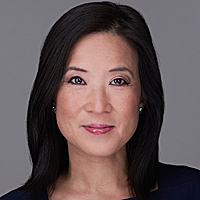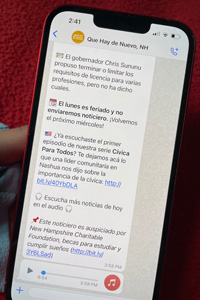Mining News Audiences On WhatsApp

The messaging platform WhatsApp reaches 2 billion people around the world, but it’s not as popular in the United States as it is in other countries. Therein lies a huge, untapped opportunity for local news outlets. Seventy-five million people in the United States (one in five) use WhatsApp, with the biggest demographic being the Hispanic community.
Two newsrooms on opposite sides of the world are pioneers in using WhatsApp as a news platform.

Simon Allison of South Africa founded the WhatsApp newspaper, The Continent, covering news across Africa. (Photo: Wikus de Wet)
Based in South Africa, Simon Allison is editor-in-chief of The Continent, a WhatsApp weekly newspaper covering Africa. He started the format in April 2020 as a way to combat COVID misinformation that was spreading through social media.
Based in New Hampshire, Daniela Allee is a senior news editor at New Hampshire Public Radio, where 4.5% of the state population is Hispanic. Allee, who’s Colombian American, saw the need to provide news and social service links in Spanish during COVID. She launched a Spanish-language news product on WhatsApp called ¿Que Hay de Nuevo, New Hampshire? or What’s new, New Hampshire?
In Zoom interviews, we discussed the enormous potential and niggly challenges of using WhatsApp Business for both newsrooms.
Building On Trust
WhatsApp group chats tend to be friends, family and close colleagues.
There’s a higher level of trust and connection organically built into groups pulled from your phone contacts.

Daniela Allee started the Spanish-language WhatsApp news product called ¿Que Hay de Nuevo, New Hampshire? for New Hampshire Public Radio. (Photo: Daniela Allee)
“WhatsApp is a closed network. It’s totally private. It’s encrypted,” Allison says. “What that means is if you receive a piece of information on WhatsApp, you’re more likely to assign it more credibility than you would if you received from Twitter or someplace that’s more public-facing.”
The Continent is a weekly digital paper in PDF format. By design, it does not update breaking news. “I don’t think viewers necessarily want breaking news all the time,” Allison explains. “It’s too much. What they want is someone to take a step back and once a week … to tell them what’s going on in a calm, analytical, measured way. And then not hear from [you] again for another week.”
Allee partnered with Hispanic community leaders in New Hampshire to figure out the best way to reach a Spanish-speaking audience. “The New Hampshire Latino community is very dispersed,” she says. “There’s not a strong community center. So, a lot of it is very dependent on who you know. You need to meet people where they are.” The group landed on WhatsApp as the most efficient distribution channel.

¿Que Hay de Nuevo, New Hampshire? on WhatsApp.
Her listeners use WhatsApp as a starting point and often end up on the radio station’s website. ¿Que Hay de Nuevo, NH? publishes three times a week on WhatsApp. Each post contains an MP3 clip of the NPR station’s local Morning Edition headlines translated into Spanish and bit.ly news links leading to NHPR’s Spanish-language page.
The Hispanic Reach
The Pew Research Center’s latest social media study estimates 46% of the Hispanic population in the U.S. uses WhatsApp, which totals about 29 million people. Many rely on WhatsApp to keep in touch with extended family in Latin America.
This is why several Spanish-language WhatsApp news sites have organically grown in the last few years. They combine news stories, investigations stemming from migrant concerns and links to social services. Allee points to Documented NY and Conecta Arizona as grassroots examples.
Potential For Video Clips
Video depends on the cost of data in each country. The Continent is not planning to use video on WhatsApp simply because the cost of data across Africa is expensive. The bigger opportunity is in the U.S., where data is bundled into monthly plans.
“I think in an environment where data costs are not an issue, the potential for video in a platform like this is huge,” says Allison, who envisions tightly produced promotable packages. “That’s the kind of content that works really well on this platform. I think if you were to make a flagship of it, that’s the kind of thing advertisers would be really interested in.”
New Hampshire Public Radio has dipped its toe into five-minute MP4 video profiles on WhatsApp called Visibles: Stories from our Community.
Two-Fold Challenge
At some point, management will ask how to measure traffic and monetize new products. Do the WhatsApp news initiatives make money? The short answer is not yet. Traditional advertisers are not banging down the doors. The main reason is the difficulty in measuring traffic and shares on WhatsApp, which is encrypted.
I reached out to a WhatsApp spokesperson and asked whether data analytics tools exist for WhatsApp Business. In an emailed statement, the spokesperson wrote: “The business app itself is similar to the regular, consumer WhatsApp — with some feature designs with small businesses in mind.” WhatsApp did not provide more specifics.

The Continent on WhatsApp.
This leaves media outlets somewhat in the dark about how to interpret their existing metrics. The Continent has 20,000 official subscribers across 117 countries (the U.S. is in the top five). These data points are based on the country codes of mobile phone subscribers to The Continent. Allison has launched reader engagement surveys that show active subscribers share the WhatsApp newspaper on average seven times. If accurate, that would bring the readership to 140,000.
Allee hits a brick wall with analytics on WhatsApp as well. ¿Que Hay de Nuevo, New Hampshire? has 460 WhatsApp subscribers, but it’s unclear how many times the newscasts are shared individually or in group chats.
“There’s not a real good sense of analytics there,” Allee says. “The best measure of analytics is when people write in or have comments or questions.… You can drop bit.lys in the [WhatsApp] messages and see how many people click through.”
The Spanish-language news initiative is funded by a variety of businesses such as an immigration law firm and the nonprofit New Hampshire Housing Finance Authority. The WhatsApp newscast recently secured a year-long sponsorship with the New Hampshire Charitable Foundation. Similarly, The Continent’s nine-person staff is funded by several African nonprofits and two U.S. entities, The Mott Foundation and the National Endowment for Democracy.
While donor funding keeps both WhatsApp newsrooms in play, revenue generation is a near-term goal for The Continent. Allison realizes the lack of measurable data is keeping advertisers at bay and he’s vocal about challenging the norm.
“I think this points to a fundamental problem within the industry, which is we don’t do anything without the numbers to support it,” he says. “And that’s fantastic when those numbers exist. But when those numbers don’t exist, it doesn’t mean that these avenues of communication are not worth pursuing.”
Pauline Chiou (@PaulineChiou) is an adjunct media professor at Iona University. Previously, she was news director at News 12 Westchester/Hudson Valley and an anchor/correspondent for CNN and CNBC.
































Comments (0)